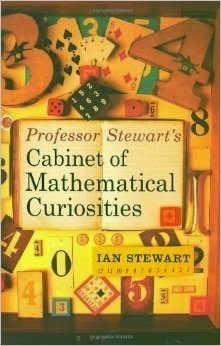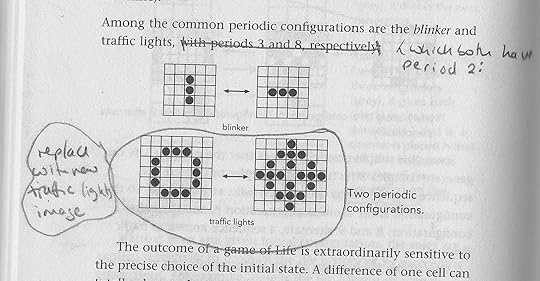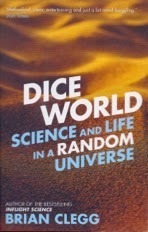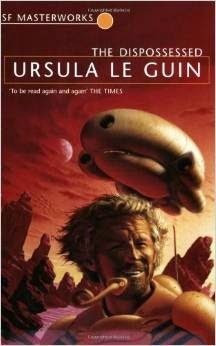Brian Clegg's Blog, page 87
October 9, 2014
Curioser and curioser
 I have just finished reading for review one of Ian Stewart's popular maths books from 2008 (I missed it first time around), and it certainly lives up to its name Professor Stewart's Cabinet of Mathematical Curiosities as it contains the most curious thing I've ever seen in a review copy of a book in all the years I've been reviewing.
I have just finished reading for review one of Ian Stewart's popular maths books from 2008 (I missed it first time around), and it certainly lives up to its name Professor Stewart's Cabinet of Mathematical Curiosities as it contains the most curious thing I've ever seen in a review copy of a book in all the years I've been reviewing.On four of the pages are hand-written corrections.
When I came across the first one, a simple change from McMahon to MacMahon, I assumed the change was actually printed in the book, to be quirky, but no, these are pencil corrections. To understand why it's so strange, you need to be familiar with the production process for a book like this.
Early editing, including copy editing, is done on bog standard Word documents (whether on a computer or printed out first). Then the book is typeset. Of course this no longer involves setting metal blocks of type in frames, but the text is imported into software that lays it out exactly how it will be on the final printed page. The result is then sent out for proof reading, both to the author and to one or more professional readers. Again this may be as a file (by now a PDF) or printed out on a laser printer.
Also around this time, there may be bound proofs produced. These look like rather scruffy paperbacks, bound up from the uncorrected proofs and are intended for early reviewers. They are easily distinguished from the final book - the cover makes it very clear what they are. Authors often get one or two of these, but no one, in my experience, uses them for proof correction, as they come out rather later than the unbound proofs.
Then, after considerable delay, the actual, final book is produced. Authors get copies of these, but in my experience they just look at the overall thing and flip through it. They certainly don't read it page by page looking for errors. Apart from anything else, they are usually fed up with the thing by now - the last thing they are going to do is read the final printed book.
And yet what I have here is a final printed hardback - not even a paperback, so certainly not a bound proof, not even one with the wrong cover on - in which someone has added pencilled corrections. It's an enigma, or, as Prof. Stewart might put it, a curiosity, that leaves me with a number of unanswered questions.
Whodunnit? Are these corrections in the very hand of the mighty Prof Stewart himself? Or someone at the publishing house? They clearly aren't from a disgruntled reader who sent the book back in, as the instructions for correction imply an insider.What was intended with that first error? There's a big difference between period 2 and period 8.Do all hardback copies carry the same mistakes? Or was this a short run that was then corrected? Do I have a strange one off copy?Was it fixed in the paperback? If you have a copy of Professor Stewart's Cabinet of Mathematical Curiosities, do take a look at page 226 and compare it with my version below. Let me know what you see!

POSTSCRIPT: Ian Stewart has kindly got in touch to clarify what probably happened. This is not his handwriting, so was done by the publisher. It seems likely this was a copy the publisher kept to accumulate details of errors they were notified of to put in a future reprint and was accidentally sent out.
I still think there are a couple of mysteries. First, why would you note errors in a copy of the book? They would be very hard to find. It would be much easier simply to note them as changes (or on an electronic copy). Secondly, this appears to be the 14th printing, but Ian implied that by the 12th this should have been fixed.
If you'd like to buy a copy yourself and make the comparison, you can get the book at Amazon.co.uk and Amazon.com. (These are the paperback versions, by the way, with different covers.)
Published on October 09, 2014 01:14
October 8, 2014
Pick a die any die
 Reading an Ian Stewart book to review it, I was reminded of a delightful old paradox, cast in the form of a gambling game. And as the author of a book called
Dice World
, I felt I had to share it.
Reading an Ian Stewart book to review it, I was reminded of a delightful old paradox, cast in the form of a gambling game. And as the author of a book called
Dice World
, I felt I had to share it.The game is played with three, rather unusual dice. There's a red one which has two 1s, two 5s and two 9s as its faces; a white one with two 3s, two 4s and two 8s as its faces and a blue one (very patriotic dice, these) with two 2s, two 6s and two 7s as its faces. The dice are not loaded.
The game is simple. Each of two players picks one of the dice and rolls - whoever gets the highest number wins. The players then repeat this, typically for 20 rolls, with the same dice. Whoever gets the lowest total has to pay the other person.
The person running the game says 'I want to make this as fair as possible, so you can choose whichever of the dice you want first, then I'll pick from what's left over.'
What would you choose to do in order to maximise your chance of winning?
...
...
Don't spend ages over it - decide what you will do before you read on.
---
---
Made a decision?
___
___
Okay...
... the answer it that you should choose to say 'No, no, I insist. You pick first. It's your game.' If the person running the game refuses, walk away.
If you haven't worked out why, these are very cunning dice. We tend to assume that if A is better than B and B is better than C, then it implies that A is also better than C. But that isn't the case with these dice.
Statistically speaking, red beats white. White beats blue. And blue beats red. So whichever of the dice the first player picks, the second player can always pick a die that will (over time) be the winner.
You can work it all out with an outcomes table if you like, but you can get a feel for it by noting that each die has a two out of three numbers that will beat at least two numbers on the lesser die.
Published on October 08, 2014 01:11
October 7, 2014
Spin the Moon
 I get lots of emails and comments on my Facebook page and Twitter about my books, most of them very positive. But occasionally people do email me to point out an error.
I get lots of emails and comments on my Facebook page and Twitter about my books, most of them very positive. But occasionally people do email me to point out an error.And sometimes I have to hold my hand up and say 'Oops, I made a mistake.' Because I'm human, and it's easily done. Even on something absolutely fundamental. I have (briefly) forgotten the name of a close friend when introducing them to someone else, so it's not shocking I may occasionally have a mental blip on some obscure bit of physics.
However, personally, if I was going to email someone to point out a mistake, I would do so apologetically and appreciating how easy it is to make a mistake. So it was a double blow when I got an email not just pointing out an error, but doing so decidedly aggressively. Headed Glaring Bit of Misinformation! the email read:
Dear Sir,Now there's three reasons I wouldn't have done this. One is I respect anyone who gets a book published, and I wouldn't be so rude to them, even if I did think they had made a mistake. Secondly I wouldn't have made such blatant use of capital letters. But most importantly, I wouldn't have done this because, unfortunately, the writer was wrong. I had not made a mistake, he had.
Began reading your latest book, “Final Frontier”, but had to quit after reading page #65, when it became obvious that you really have no clue as to what you are talking about.
You are discussing the construction of a paternoster-type space elevator on the Moon, when you state “The mechanism would be designed to swing at just the right speed to match THE ROTATION OF THE MOON”. Unless I have been lied to by every book on planetary physics that I have ever read, the Moon is tidally locked to the Earth, AND HAS NO ROTATION. Perhaps you somehow missed that small bit of information?
As I said, I stopped reading the book at that point, and will probably avoid your works in the future.
To be fair, it's an easy mistake to make (which is why it's best not to be so hard on poor authors who slip up). The Moon is, indeed, tidally locked to the Earth - and that gives a mental image of it being fixed in position. But what this means is that the Moon's speed of rotation is just right to keep the same face pointing towards the Earth as it orbits. It's not that it doesn't rotate, just that it rotates at a particular, 'locked' speed. (Technically it's not so much locked as self-correcting.)
The Moon doesn't rotate very quickly - but that's not a bad thing. At the equator, the Moon's rotational velocity is about 4.5 metres/second. To put that into context, world class athletes run 100 metres in just under 10 seconds, or 10 metres per second, so at a little under half this, the Moon's equatorial surface is rotating at a jogging pace.
My message, then, is don't expect perfection from a science writer - but it pays to be polite when pointing out errors for many reasons.
Published on October 07, 2014 01:30
October 6, 2014
Black and white politics
When I was young, I believe a lot of people went to the Saturday morning pictures (cinema) and amongst other things, they would watch cowboy adventures in which it was very easy to tell who were the bad guys and who were the good, because the bad guys wore black hats, and the good white. When I grew up I soon realised life was more complicated. It helped, I think, that I went into the sciences, because the message there is usually 'It's more complicated than you thought', a message that sadly doesn't seem to have spread to many people's politics.
 I'd say the majority of my friends on Facebook are left wing politically (I will discuss my own POV at the end), which is fine, but what does irritate me it that they have the tendency to repost political propaganda that suffers wildly from the black hat/white syndrome. The other day, I had cause to raise both eyebrows when confronted with this piece of work, apparently from leftunity.org.
I'd say the majority of my friends on Facebook are left wing politically (I will discuss my own POV at the end), which is fine, but what does irritate me it that they have the tendency to repost political propaganda that suffers wildly from the black hat/white syndrome. The other day, I had cause to raise both eyebrows when confronted with this piece of work, apparently from leftunity.org.
For me, this is the worst kind of black hat/white hat politics, because there is a serious point, worth considering behind the illogical rhetoric - but it is so covered up by that rhetoric that for anyone who doesn't have a knee-jerk positive reaction to the message, it is counterproductive.
Why don't I like it? To start with, the statements on the poster (or whatever you call these e-snippets) are blatantly untrue. There is money for schools - c £98 billion, and there is money for the health service (I'm taking "hospitals" to be a one-word version of "the health service") - c £133 billion. That's rather a lot of money, actually - so it's hard to imagine why anyone would say 'there's no money'. Is there money for war? Yes, there is money for that too - currently around £33 billion of military spending, though a fair amount of this isn't strictly 'for war'. So the statements themselves are almost meaningless, and mostly untrue.
However, I'm told I'm being too literal (allegedly a failing of the scientific education, though why would you want not to be literal about political information unless your intention is to mislead people)? What this really means is that we can't find more money, on top of the budget, for schools and hospitals, but we can for war. If this were true, it would be worth of serious comment - but I haven't seen any evidence that the fact we might do some bombing raids on the disgusting and despicable ISIS, which is what triggered this campaign, is going to mean we need extra money for the defence budget. So, again, the comparison appears to be an attempt to mislead or confused.
When I pointed this out, the person who posted it responded by saying 'I've lost my inflationary pay rise and my increment because there's "no money". Money for cruise missiles at £1.5 million apiece, though.' While I sympathise to some extent (while pointing out that, as someone who is self-employed, I current earn almost exactly the same as I did when I left BA 20 years ago, with no 'inflationary pay rise' over 20 years), again it's a false comparison. You can argue that the budget was wrong, and we should have had more for his/her pay and less for defence (unless he/she happened to work in defence). You can argue, as I probably would, that we could save a lot by getting rid of Trident. But that's not what this campaign is saying.
The reason I think this kind of thing is a real shot in the foot comes back to my own political affiliations. I am a floating voter. I have voted for all three main political parties in my time, though by default I am probably a liberal democrat (cousin Nick insists). But there's a real lesson from that one time I voted Tory. I come from a naturally Labour voting background - from a North West, working class family that read the Manchester Guardian until it did the dirty and moved down south. I wouldn't have thought of voting Tory. But when I had my first chance to vote, while at university, I got so fed up of the way my left wing friends distorted the facts in exactly this kind of way that I voted Tory in rebellion.
So, by all means make your point about everything the other parties do wrong. But do it honestly and fairly, without ad hominem attacks, and without using meaningless propaganda. Then I will listen with interest. But do this kind of thing and it will instantly make me bolshie and inclined to do the opposite.
 I'd say the majority of my friends on Facebook are left wing politically (I will discuss my own POV at the end), which is fine, but what does irritate me it that they have the tendency to repost political propaganda that suffers wildly from the black hat/white syndrome. The other day, I had cause to raise both eyebrows when confronted with this piece of work, apparently from leftunity.org.
I'd say the majority of my friends on Facebook are left wing politically (I will discuss my own POV at the end), which is fine, but what does irritate me it that they have the tendency to repost political propaganda that suffers wildly from the black hat/white syndrome. The other day, I had cause to raise both eyebrows when confronted with this piece of work, apparently from leftunity.org.For me, this is the worst kind of black hat/white hat politics, because there is a serious point, worth considering behind the illogical rhetoric - but it is so covered up by that rhetoric that for anyone who doesn't have a knee-jerk positive reaction to the message, it is counterproductive.
Why don't I like it? To start with, the statements on the poster (or whatever you call these e-snippets) are blatantly untrue. There is money for schools - c £98 billion, and there is money for the health service (I'm taking "hospitals" to be a one-word version of "the health service") - c £133 billion. That's rather a lot of money, actually - so it's hard to imagine why anyone would say 'there's no money'. Is there money for war? Yes, there is money for that too - currently around £33 billion of military spending, though a fair amount of this isn't strictly 'for war'. So the statements themselves are almost meaningless, and mostly untrue.
However, I'm told I'm being too literal (allegedly a failing of the scientific education, though why would you want not to be literal about political information unless your intention is to mislead people)? What this really means is that we can't find more money, on top of the budget, for schools and hospitals, but we can for war. If this were true, it would be worth of serious comment - but I haven't seen any evidence that the fact we might do some bombing raids on the disgusting and despicable ISIS, which is what triggered this campaign, is going to mean we need extra money for the defence budget. So, again, the comparison appears to be an attempt to mislead or confused.
When I pointed this out, the person who posted it responded by saying 'I've lost my inflationary pay rise and my increment because there's "no money". Money for cruise missiles at £1.5 million apiece, though.' While I sympathise to some extent (while pointing out that, as someone who is self-employed, I current earn almost exactly the same as I did when I left BA 20 years ago, with no 'inflationary pay rise' over 20 years), again it's a false comparison. You can argue that the budget was wrong, and we should have had more for his/her pay and less for defence (unless he/she happened to work in defence). You can argue, as I probably would, that we could save a lot by getting rid of Trident. But that's not what this campaign is saying.
The reason I think this kind of thing is a real shot in the foot comes back to my own political affiliations. I am a floating voter. I have voted for all three main political parties in my time, though by default I am probably a liberal democrat (cousin Nick insists). But there's a real lesson from that one time I voted Tory. I come from a naturally Labour voting background - from a North West, working class family that read the Manchester Guardian until it did the dirty and moved down south. I wouldn't have thought of voting Tory. But when I had my first chance to vote, while at university, I got so fed up of the way my left wing friends distorted the facts in exactly this kind of way that I voted Tory in rebellion.
So, by all means make your point about everything the other parties do wrong. But do it honestly and fairly, without ad hominem attacks, and without using meaningless propaganda. Then I will listen with interest. But do this kind of thing and it will instantly make me bolshie and inclined to do the opposite.
Published on October 06, 2014 01:29
October 3, 2014
Only £33? I pay you?
 Phonetastic, pop pickers!The other day I was walking past a bus stop and paused to admire an advert for the new Amazon smartphone. I was told that I could get it for only £33 pounds a month on O2. (Actually, as was the case initially with the iPhone, you can only get it on O2.)
Phonetastic, pop pickers!The other day I was walking past a bus stop and paused to admire an advert for the new Amazon smartphone. I was told that I could get it for only £33 pounds a month on O2. (Actually, as was the case initially with the iPhone, you can only get it on O2.)Whoa, I thought. That's more than I pay for a real smartphone. Now I now that's a bit unfair as this is a fully featured Android phone, and I don't want to start the old iPhone/Android rivalry (though, of course, iPhones are better), but my point was this. Yes, the Amazon Fire phone is a nice smartphone with a couple of unique but hardly showstopping features. Set against which it has some limitations that make it anything but one of the best Android options. But the point is that this is a phone that, like it or not, has very strong ties to one retailer (a retailer that wants to rule the world). Which gives said retailer huge benefits by having a direct link to my pocket and activities. So, really, should I have to pay as much or more than I do for an ordinary smartphone?
Usually if you get something tied to a particular brand you expect it to be cheap - or even for them to pay you to use it. Surely Amazon has got this back to front. If Amazon paid me to use their phone, I could understand it. But as they expect me to pay a premium, I'm afraid I'll be staying well away. (And did I mention, it's not an iPhone?)
Published on October 03, 2014 01:37
October 2, 2014
Does Nigel Lawson's defeat mean that religions should lose charitable status?
 I was interested to see that Nigel Lawson's anti-science Global Warming Policy Foundation has been rapped on the knuckles by the Charity Commission for not meeting the requirement for an educational charity to be unbiassed (and, by implication, evidence based). I presume the same requirements don't apply to religious charities, as surely they would be in trouble too.
I was interested to see that Nigel Lawson's anti-science Global Warming Policy Foundation has been rapped on the knuckles by the Charity Commission for not meeting the requirement for an educational charity to be unbiassed (and, by implication, evidence based). I presume the same requirements don't apply to religious charities, as surely they would be in trouble too.Some while ago I wrote a post about a visit from the Jehovah's Witnesses and how their leaflet inspired me to realise that it is difficult to apply the Bible to everyday 'big questions' like 'What should we do about terrorists?' because the advice is so conflicting that it is possible to come up with pretty well diametrically opposed recommendations.
Shortly after writing this I had a bit of an epiphany*. I've always struggled to understand how climate change deniers can come up with such a strangely selective view that went against the majority scientific consensus - but now it was obvious. They don't use a scientific approach, they use a religious one.
The scientific approach is to use the theory best supported by experts in the field given the current evidence, until new evidence suggests we should do otherwise. There is always some contradictory evidence, and often one or two experts who disagree with the majority, but it is clearly not providing a good scientific view to take an alternative theory as 'fact' when it overwhelming countered by the best supported theory - the scientific consensus, as it is often called in climate change. So, for instance, most cosmologists support the Big Bang theory. Not all of them - and it could eventually prove wrong. But for the moment it is the theory that is best supported by the evidence, and so deserves the status of being the theory we currently work with.
However, those using a religious argument have a different approach. Because a source like the Bible or the Koran has so many different and contradictory concepts and interpretations, it is possible to support pretty well any thesis using religious argument. All you do is pick and choose the quotations from the Bible etc. that support your view and ignore the rest. And that's exactly what climate change deniers do. (As do those who think science is unfairly against alternative medicine, or ghosts or whatever.) They pick and choose the evidence that fits their worldview.
This is totally unscientific - but it is inevitably how arguments based on religious documents work. This isn't science, it's religion. And those who talk this way about climate change (or any other application of science) are entirely missing the point when they use this approach.
So we can see why it is that the GWPF will inevitably struggle to meet that 'unbiassed' requirement for an education charity. But, as I say, should we also be asking the Charity Commissioners to ensure that religious institutions given charitable status (think of the arguments over whether Scientology should be given charitable status) are equally required to be unbiassed or to lose that benefit? It's an intriguing thought.
* Yes, I do know what I've done there.
Published on October 02, 2014 01:04
October 1, 2014
The Dispossessed - Review
 I ought to hate this book. I was writing something about instantaneous transmitters and wanted to include Ursula Le Guin's ansible. I had read somewhere that its development and how it worked was explained in this book. It turns out it gets two mentions, each all of two lines long in 319 pages. But I don't care - because it's a great book.
I ought to hate this book. I was writing something about instantaneous transmitters and wanted to include Ursula Le Guin's ansible. I had read somewhere that its development and how it worked was explained in this book. It turns out it gets two mentions, each all of two lines long in 319 pages. But I don't care - because it's a great book.I confess, I've never really read Le Guin apart from a not particularly enthusiastic attempt at The Left Hand of Darkness. The science fiction I largely read when I was younger was from the 1950s greats and the 1960s new wave, and while I read their later work too, and have started picking up on some newer writers, there's a big gap in my experience, including pretty well everything Le Guin wrote.
The book does have some science going on - the main character is a physicist developing a theory on time (hence the ansible cropping up), which seems mainly to be based on the block universe - but it's not really what the novel is about. It's far more an exploration of political systems. Our hero, Shevek, lives on the desolate Anarres, where humans can live, but are always fighting for survival. But he begins to find out more about and even to correspond with the twin planet Urras, which is lush and beautiful, eventually breaking with tradition and visiting it.
The drama comes from the juxtaposition of very different political systems. The main country on Urras is decadent capitalist, though the planet also has a Soviet-style communist country. Anarres is anarchist communist - not only is there genuinely no personal property, there are no laws, no rules.
Cleverly, in making the contrast between Anarres and Urras, Le Guin brings out the faults in both systems. It might seem at first that, despite the hardships, the anarchist Anarres is a paradise, because Le Guin manages to come up with a structure that would allow anarchy to work practically as a regime - no mean feat - but in reality humanity likes rules, and they are actually there, concealed and unspoken, until Shevek begins to break them.
It's absolutely not my kind of science fiction, and yet I found it both fascinating and enjoyable. I just wish I also now knew more about ansibles.
You can get The Dispossessed from Amazon.co.uk and Amazon.com (why no Kindle version, btw - it should have one to bring it to a new audience.)
Published on October 01, 2014 01:08
September 30, 2014
Who is in the running for the Nobels?
 For the outside world, exactly who wins Nobel Prizes in the science is fairly academic (geddit?) - and even for those with a professional interest it may sometimes seem that the reason for the awards can be sliced pretty thin these days. The early prizes do seem often to have been for more 'big' work than the more subtle modern ones. But having said that, we also always get some goodies.
For the outside world, exactly who wins Nobel Prizes in the science is fairly academic (geddit?) - and even for those with a professional interest it may sometimes seem that the reason for the awards can be sliced pretty thin these days. The early prizes do seem often to have been for more 'big' work than the more subtle modern ones. But having said that, we also always get some goodies.I didn't realize it until they sent me a press release, but Thomson Reuters do an annual prediction of the likely runners and riders - useful in case you fancy a flutter. So here are this years' favourites according to TR. On the physics side, I rather fancy the Quantum Spin Hall effect, but that's just me...
P.S. I don't know why Economics is treated as a science either.
PHYSIOLOGY or MEDICINEJames E. Darnell, Jr.Vincent Astor Professor Emeritus, Laboratory of Molecular Cell Biology, Rockefeller University
New York, NY USA
-and-
Robert G. RoederArnold and Mabel Beckman Professor, Laboratory of Biochemistry and Molecular Biology, Rockefeller University
New York, NY USA
-and-
Robert TjianProfessor of Biochemistry, Biophysics, and Structural Biology, Department of Molecular and Cell Biology, University of California Berkeley, and President, Howard Hughes Medical Institute
Berkeley, CA, and Chevy Chase, MD USA
For fundamental discoveries concerning eukaryotic transcription and gene regulationDavid JuliusMorris Herzstein Chair in Molecular Biology and Medicine,
Professor and Chair of Physiology, University of California San Francisco
San Francisco, CA USA
For elucidating molecular mechanisms of pain sensationCharles LeeProfessor and Scientific Director of the Jackson Laboratory for Genomic Medicine
Farmington, CT USA -and- Stephen W. SchererSenior Scientist and Director, The Centre for Applied Genomics, The Hospital for Sick Children, Professor and Director, McLaughlin Centre, University of Toronto
Toronto ON CANADA -and- Michael H. WiglerProfessor and Head, Mammalian Cell Genetics Section, Cold Spring Harbor Laboratory
Cold Spring Harbor, NY USAFor their discovery of large-scale copy number variation and its association with specific diseases
PHYSICSCharles L. Kane
Class of 1965 Endowed Term Chair Professor of Physics, University of Pennsylvania
Philadelphia, PA USA -and- Laurens W. Molenkamp
Professor of Physics and Chair of Experimental Physics, University of Würzburg
Würzburg, GERMANY -and- Shoucheng ZhangJ.G. Jackson and C.J. Wood Professor of Physics, Stanford University
Stanford, CA USA
For theoretical and experimental research on the quantum spin Hall effect and topological insulators James F. Scott Director of Research, Department of Physics, University of Cambridge
Cambridge, UK
-and- Ramamoorthy Ramesh Professor, Physics and MSE, and Associate Lab Director for Energy Technologies, University of California BerkeleyBerkeley, CA USA
-and-
Yoshinori Tokura* Director, RIKEN Center for Emergent Matter Science, andProfessor, Department of Applied Physics, The University of TokyoSaitama and Tokyo, JAPAN
For their pioneering research on ferroelectric memory devices (Scott) and new multiferroic materials (Ramesh and Tokura). *Tokura was previously named a Citation Laureate in 2002.Peidong YangS. K. and Angela Chan Distinguished Chair in Energy, Department of Chemistry, Materials Science and Engineering, University of California Berkeley, Kavli Energy Nanoscience Institute, and Materials Science Division, Lawrence Berkeley National Laboratory
Berkeley, CA USA
For his contributions to nanowire photonics including the creation of first nanowire nanolaser
CHEMISTRYCharles T. Kresge
Chief Technology Officer, Saudi Aramco, Dhahran
SAUDI ARABIA
-and- Ryong RyooDirector, Center for Nanomaterials and Chemical Reactions, Institute for Basic Science and Distinguished Professor, Department of Chemistry, Korea Advanced Institute of Science and Technology (KAIST)
Daejeon, SOUTH KOREA
-and- Galen D. StuckyE. Khashoggi Industries, LLC Professor in Letters and Science, University of California Santa Barbara
Santa Barbara, CA USA
For design of functional mesoporous materialsGraeme MoadChief Research Scientist, CSIRO
Clayton, Victoria, AUSTRALIA
-and- Ezio RizzardoCSIRO Fellow, CSIRO
Clayton, Victoria, AUSTRALIA
-and-
San H. ThangChief Research Scientist, CSIRO
Clayton, Victoria, AUSTRALIA
For development of the reversible addition-fragmentation chain transfer (RAFT) polymerization process Ching W. Tang Professor of Chemical Engineering and Bank of East Asia Professor, Institute for Advanced Study, University of Rochester, and Chair Professor in the Departments of Electrical and Computer Engineering, Chemistry, and Physics, Hong Kong University of Science and Technology
Rochester, NY USA and Hong Kong, CHINA -and- Steven Van Slyke Chief Technology Officer, Kateeva
Menlo Park, CA USAFor their invention of the organic light emitting diode
ECONOMIC SCIENCESPhilippe M. Aghion
Robert C. Waggoner Professor of Economics, Harvard University
Cambridge, MA USA
-and- Peter W. HowittLyn Crost Professor Emeritus of Social Sciences and Professor Emeritus of Economics, Brown University
Providence, RI USA
For contributions to Schumpeterian growth theoryWilliam J. BaumolProfessor of Economics and Harold Price Professor of Entrepreneurship, New York University
New York, NY USA
-and- Israel M. KirznerEmeritus Professor of Economics, New York University
New York, NY USA
For their advancement of the study of entrepreneurismMark S. GranovetterJoan Butler Ford Professor and Chair of Sociology, and Joan Butler Ford Professor in the School of Humanities and Sciences, Stanford University
Stanford, CA USA
For his pioneering research in economic sociology
"Nobel Prize". Via Wikipedia
Published on September 30, 2014 00:29
September 29, 2014
Google walks
 Start of the journey - BBC Wiltshire receptionYesterday I made my regular appearance on BBC Wiltshire, but I was without a car, so experienced the joys of a bus in, and decided to walk back, a distance of just over four miles. What made it different, and really rather fun, was I did it with a walking sat nav.
Start of the journey - BBC Wiltshire receptionYesterday I made my regular appearance on BBC Wiltshire, but I was without a car, so experienced the joys of a bus in, and decided to walk back, a distance of just over four miles. What made it different, and really rather fun, was I did it with a walking sat nav.It's not the first time I've used GPS on a phone for guidance while walking - in fact I've done it when finding my way across cities on foot for years - but what I've always done before is kept my phone in my hands, glancing at the map to see where I should go. This time, I plugged in a pair of earbuds, stuck the phone in my pocket and let the software do the talking. And it worked brilliantly.
 Ms Google starts me offOne essential before getting started on this was to use Google Maps. More often than not I use Apple's mapping app - after its initial teething problems it works fine for most uses, including my strolls around cities. But for the kind of journey I was about to do it has a fatal flaw. It doesn't know about footpaths (certainly not footpaths in Swindon). Google does - and it makes a real difference to the walk.
Ms Google starts me offOne essential before getting started on this was to use Google Maps. More often than not I use Apple's mapping app - after its initial teething problems it works fine for most uses, including my strolls around cities. But for the kind of journey I was about to do it has a fatal flaw. It doesn't know about footpaths (certainly not footpaths in Swindon). Google does - and it makes a real difference to the walk.So off I set with the slightly whiny, but assertive American woman telling me what to do in my ears. It was strangely intimate. When a car sat nav tells you what to do, it is clearly coming from that piece of kit on the dashboard, but when a voice in your ears tells you to turn left onto Regent Street, there really is quite a strong urge to respond and make it a conversation.
As always when I take these mid-range walks across Swindon it's a delight that's rather similar to the experience of travelling on a narrowboat on one of the UK's canals. There's that same mix of passing close by everything from industrial architecture to open fields at a pace where you can really look around and observe things, seeing the world from an angle you don't usually get to experience.
Ms Google did the job perfectly, though I did find it a little unnerving, only following voice commands. Three times I gave in and got the phone out to check the map (especially when she appeared to be directing me to cross the road and walk up a set of steps, as indeed she was), but each time what I thought she meant was correct. She even got a little cheeky.

Occasionally she would make apparently reassuring comments that were clearly intended to wind me up, as they would only be of use to a scout. I would be powering up a steep sloping bend and she would suddenly say 'Head north west.' Now, bearing in mind the phone was in my pocket, unless I had a compass in hand, or had one of those pairs of shoes (Wayfinders) with a compass in the heel I always wanted as a kid, but wasn't allowed because my mum (rightly) said the compass would be rubbish, this information was totally without value. Still, it broke the awkward silences.
All in all, a real success. I think Ms Google will be my companion on many more trips to come...
Published on September 29, 2014 00:31
September 26, 2014
What's the best science-related quote?
 I enjoy wheeling out the odd science-related quote, and would be interested to collect more. To be really great, I think a quote like this needs to be pithy, funny... and make you think. Do you have a favourite? (Please ensure they are from a reliable source.)
I enjoy wheeling out the odd science-related quote, and would be interested to collect more. To be really great, I think a quote like this needs to be pithy, funny... and make you think. Do you have a favourite? (Please ensure they are from a reliable source.)It's hard to go wrong with Rutherford's famous:
All science is either physics or stamp collecting.Which is particularly useful to wind up biologists. I am also rather fond of Konrad Lorenz's advice, which rather a lot of scientists could do to consider:
It is a good morning exercise for a research scientist to discard a pet hypothesis every day before breakfast.But the one I'll leave you with this morning, which I shall dedicate to cosmologists and string theorists, is:
There is something fascinating about science. One gets such wholesale returns of conjecture out of such a trifling investment of fact.
Published on September 26, 2014 02:11



